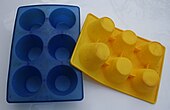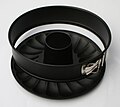baking pan
The baking pan is used for baking of cakes , pies , breads , pastries and pies . Originally made of stoneware or hot-dip tinned copper, today a baking pan is usually made of enamelled or tin-plated sheet iron , often with a non-stick coating . There are also transparent baking tins made of heat-resistant borosilicate glass . Baking molds made of silicone are relatively new to the market . In contrast to metal baking molds, they are flexible and can therefore be removed more easily from the baked goods.
The main purpose of baking molds is to prevent doughs and masses such as sponge and sponge cake or high-fat fillings from flowing apart until the mass solidifies, usually because the protein it contains coagulates in the heat of the oven. Unbaked bread , small baked goods and many yeast pastries are often sufficiently dimensionally stable to be baked "freely" on the tray , but bread, mares , stollen etc. are also often baked in baking molds. So that the shape and content can be separated from each other after baking, there are non-stick coated baking tins, non-coated ones have to be greased beforehand or covered with baking paper . The fat layer can also be dusted with flour or breadcrumbs .
Model and cookie cutters for gingerbread , cookies , etc. are not counted among the baking molds .
Emergence
Some baking pans were probably preceded by the use of bowls, bowls and kettles.
variants
Bowl and wreath shapes
For cakes like bundt cake and flatter wreath cakes. For pudding there are special pudding molds . The later added hole in the middle serves to distribute heat more quickly and evenly. In Franconia, cakes in wreath or Gugelhupf form are less often called Schatt.
Box shapes
are rectangular and about the same width as they are high. Typical uses are sponge cakes, pies, meat loaf and various types of bread, e.g. B. have a fatty dough like white bread . In Switzerland the name cake pan is common.
Springform pans
are usually round, but sometimes also angular or differently shaped (e.g. heart shape), mostly flat baking pans made of two parts: A tinny, adjustable ring forms the side wall, in which an exchangeable base is clamped. With flat bottom, it serves mainly for baking cake and flan , with a floor with a central fireplace (so-called "tube sheet") it replaces a ring shape for sponge cakes. In contrast to other baking molds, the finished cake does not have to be overturned, but the mold pops open by opening the clamping lever of the outer ring, the wall and base separate from each other. Such baking molds are also made with leak protection. The lower support plate is slightly larger and, thanks to its shape, serves as a collecting channel.
Motif baking molds
are baking molds that allow cakes to be baked as figures, motifs, symbols or other images in three-dimensional form. Examples are motif baking molds that z. B. in the form of cars, ships, etc. or current characters from film and television such as Mickey Mouse, Spongebob, Spider-Man and the like. Ä. Form. In Europe, some motif baking molds are consistently on the market (preferably timeless holiday motifs such as rabbits, Christmas or snowmen). Motifs from popular TV series are produced by licensed (mostly American) mold manufacturers and are mainly offered in the United States. Special shapes can also be borrowed from loan shops in Germany (baking mold rental). The shapes are mostly made of smoothed aluminum, stainless steel or solid cast aluminum with a non-stick coating. The size is about 30 cm × 25 cm × 6 cm. The dough volume is between 1.5 and 2.5 liters.
Baking mold dressings
Baking mold associations (for normal oven sizes) are baking trays into which several identical baking motifs are pressed. Typical examples are éclair forms (sponge fingers) and bear paw or madeleine baking trays. But other motifs (bears, hearts and the like) can be pressed into baking mold associations as muffins. Baking mold associations from North America with various motifs (muffins) such as butterflies, dinosaurs, beetles, insects, zoo animals and the like are increasingly coming onto the German market. These imported baking mold associations, like the motif baking molds, are usually made of cast aluminum with a non-stick coating. The size is about 10 cm × 8 cm × 5 cm.
Baking bowls made of glazed stoneware
are still made by hand in some pottery today. The cake is baked in the bowl. But then he doesn't have to be thrown out of the mold. It is served, cut and lifted out of the mold piece by piece.
Others

There are also various baking molds for small baked goods such as muffins , Yorkshire pudding or small pies (a tray with several bowl-like indentations) or special decorative shapes, e.g. B. for Christmas and Easter cookies.





